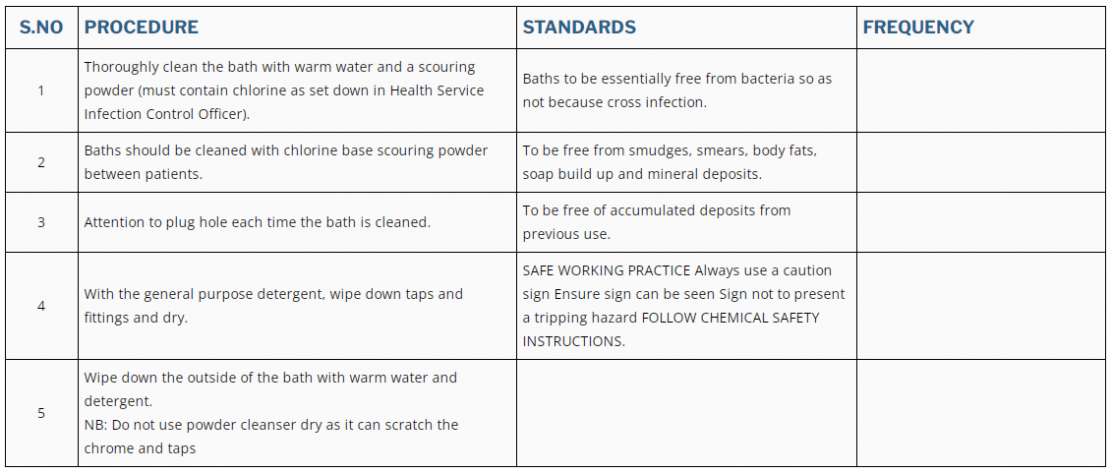With a strategic vision to deliver bespoke services at an affordable cost to the customers, add valve to the customers and crave niche in the highly competitive market. To provide affordable bespoke Hospitality & Housekeeping services with consistency and ensure a clean, safe and healthy environment
Section 3
BATHROOM & TOILETS
3.1 Cleaning-Hand Wash Basins
S.NO | Procedure | Standards | Frequency |
1 | Thoroughly clean the basin with warm chemical solution inside and outside. | Hand basins should be clean and free from soap build up, smudges, smear, body fats and mineral deposits both internally. Removal of contamination from previous use. | |
2 | Special attention to soap runs under the basins. | SAFE WORKING PRACTICE Always use a caution sign Ensure sign can be seen Sign not to present a tripping hazard FOLLOW CHEMICAL SAFETY INSTRUCTIONS. | |
3 | Tap fittings to be washed and dried. NB: Do not use powder cleanser dry as can scratch the chrome on the taps. | ||
4 | Where water pipes and waste pipes are open beneath the basin, wipe over with a damp cloth. | ||
5 | Clean the plug hole using scouring powder cloth and small brush. |
3.2 Cleaning-Stainless Steel Sink
S.NO | Procedure | Standards | Frequency |
1 | Sinks are to be cleaned with a powder cleanser. | Sink should be free of grease, dirt, dust, encrustations, marks, stains and have a bright appearance. | |
2 | First wet the sink. Shake on a little powder cleanser and work around the surface with a cloth includes the plug hole. | ||
3 | After removing soil age and any stains flush away with running water. Wipe down the surface of the sink |
3.3 Cleaning-Taps & Fittings (Fixtures)
S.NO | Procedure | Standards | Frequency |
1 | Wipe over taps and fittings with a damp cloth and detergent. | Taps and fittings should be free from soap build up smudges, dust and mineral deposits. | |
2 | If heavily soiled, shake a little powder cleanser onto a wet cloth, fold cloth over and rub into a paste and polish. NB: Do not use powder cleanser dry as it can scratch the chrome on the taps. | SAFE WORKING PRACTICE Always use a caution sign Ensure sign can be seen Sign not to present a tripping hazard FOLLOW CHEMICAL SAFETY INSTRUCTIONS. | |
3 | Care should be taken to clean underside of taps and fittings. | ||
4 | Taps should be dried on cleaning. |
3.4 Cleaning-Mirror
S.NO | Procedure | Standards | Frequency |
1 | Using warm water and a small quality of detergent shampoo based if if possible or the best is use the glass cleaning chemical as required and trained, using a damp cloth, wipe over the mirror and surround, then using a dry lint free cloth and buff the mirror to a clean dry finish. | Mirrors are free of steaks, soil, smudges, soap buildup and oxide deposit. | |
2 | SAFE WORKING PRACTICE Always use a caution sign Ensure sign can be seen Sign not to present a tripping hazard FOLLOW CHEMICAL SAFETY INSTRUCTIONS |
3.5 Cleaning-Toilets
S.NO | Procedure | Standards | Frequency |
1 | Wash urinals with hot water and detergent using powder cleanser. Scrub any deposits off, paying particular attention to edges and corners. | Urinals are free from streaks, oil smudges, soap build up, oxide deposits and odors that are distasteful or unpleasant. | |
2 | Persistent stains can be removed with a non-corrosive acid. Before using the chemical, all safety measures including protective gear must be followed, Refer to. | SAFE WORKING PRACTICE Always use a caution sign Ensure sign can be seen Sign not to present a tripping hazard FOLLOW CHEMICAL SAFETY INSTRUCTIONS. | |
3 | Environmental Services Department Safety Data Manual. | ||
4 | The use of urinal blocks to stop smell is not permitted at our Health Services. |
3.6 Cleaning-Urinals
S.NO | Procedure | Standards | Frequency |
1 | Brush the inside surface of the toilet bowl with detergent; if badly soiled use a little scouring powder and brush. flush away powder on completion. Scrub under toilet rim. | Porcelain and plastic surfaces are free from smudges, body fats, soap build up and mineral deposits. Metal surfaces are free from streaks soil; smudges soap build-up and oxide deposits. | |
2 | Using a wet cloth and detergent, thoroughly clean both sides of the seat, outside of the bowl, and with a clean cloth. Note: Toilet brush not to be used for this procedure. | Wall tiles and fixtures (including soap and cream dispenser and towel holders) area free of dust, grit, smudges/streaks, mold, soup build up and mineral deposits. | |
3 | Thoroughly clean walls, edges, handrails and corners with warm water and detergent, then dry all fittings and fixtures. | Plumbing fixtures are free of smudges, dust, soap build up and mineral deposits. Bathroom fixtures area free from odors that are distasteful or unpleasant. | |
4 | Clean the door and handles both sides with warm water and detergent. | Polished surfaces are of a uniform lustre. Sanitary disposal unit are clean and functional. Consumable items are in sufficient supply. | |
5 | Replace toilet paper, liquid soap and paper towel if required. | Internal and external doors and door frames are free of dust, grit, lint, soil, film, finger prints and cobwebs. | |
6 | Wipe out paper towel dispenser before recharging. | Doors and doorframes are free of marks caused by furniture equipment or staff air vents, relief grilles and other ventilation outlets are left unblocked and free of dust, grit, soil, film, cobwebs, scuffs and any other marks. | |
7 | Ensure paper is loaded correctly so that towel will dispense. | Door tracks and door jambs are free of grit and other debris. Polished surfaces are of uniform lustre. The toilet and surrounds should be free of soil age marks and liquids. | |
8 | Damp mop the floor when leaving with hot water and detergent. | SAFE WORKING PRACTICE Always use a caution sign Ensure sign can be seen Sign not to present a tripping hazard FOLLOW CHEMICAL SAFETY INSTRUCTIONS. |
3.7 Cleaning-Shower
S.NO | Procedure | Standards | Frequency |
1 | Using hot water and detergent scrub the wall with a white doodlebug. NB: Do not use course pad for this task, as damage will result to the surface of the shower walls. | Shower should be free of soap, dust, grit, smudges/streaks, mineral deposits and mold. | |
2 | Clean taps and fittings with warm water and detergents to remove any soap deposits. NB: Do not use powder cleanser dry or it will scratch the chrome on the taps. | Taps and fittings to be free of smudges, dust, soap build up and mineral deposits. | |
3 | Rinse the lower end of the shower screen in warm water rinse walls and fittings and dry. | Shower screen to be clean and free of stains, smudges, smears, odors, mold and body fats to remove excess soap. | |
4 | Scrub shower base with doodlebug and detergent as for walls. Rinse and dry. | SAFE WORKING PRACTICE Always use a caution sign Ensure sign can be seen Sign not to present a tripping hazard FOLLOW CHEMICAL SAFETY INSTRUCTIONS. |
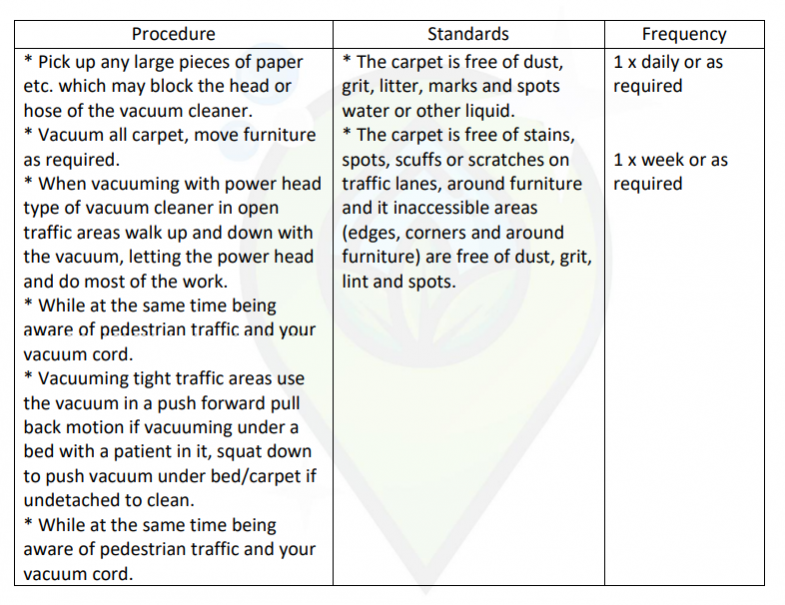
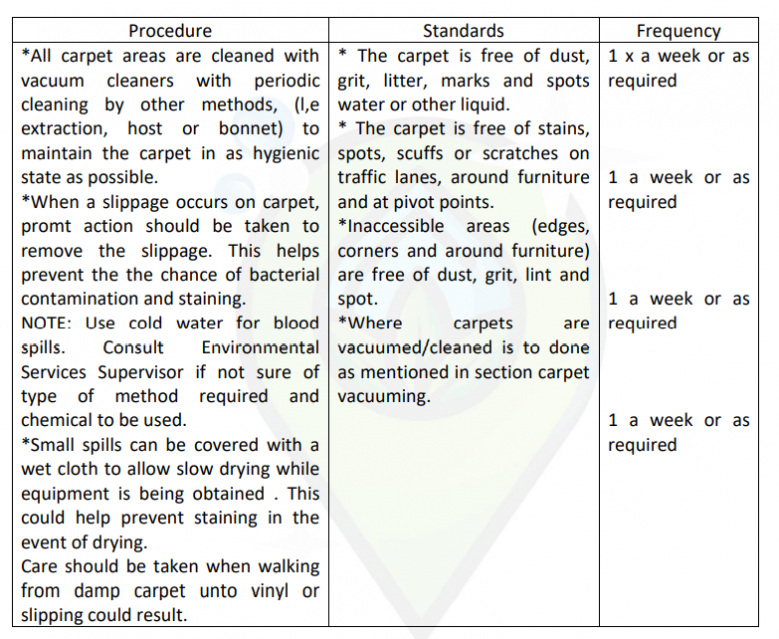


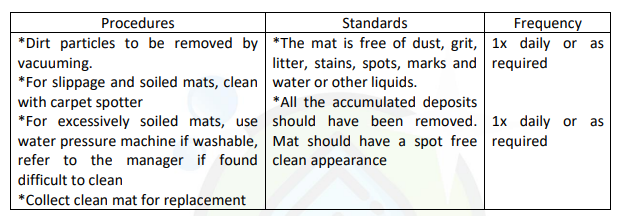



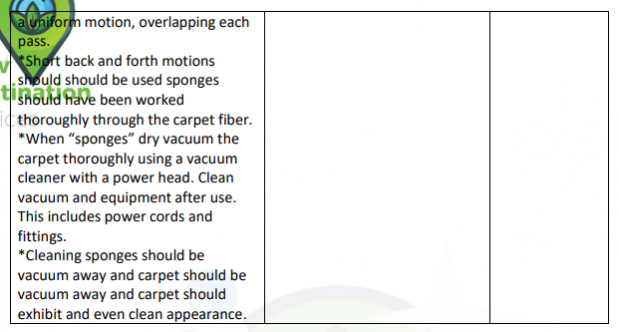
3.8 Cleaning-Baths
S.NO | Procedure | Standards | Frequency |
1 | Thoroughly clean the bath with warm water and a scouring powder (must contain chlorine as set down in Health Service Infection Control Officer). | Baths to be essentially free from bacteria so as not because cross infection. | |
2 | Baths should be cleaned with chlorine base scouring powder between patients. | To be free from smudges, smears, body fats, soap build up and mineral deposits. | |
3 | Attention to plug hole each time the bath is cleaned. | To be free of accumulated deposits from previous use. | |
4 | With the general purpose detergent, wipe down taps and fittings and dry. | SAFE WORKING PRACTICE Always use a caution sign Ensure sign can be seen Sign not to present a tripping hazard FOLLOW CHEMICAL SAFETY INSTRUCTIONS. | |
5 | Wipe down the outside of the bath with warm water and detergent. NB: Do not use powder cleanser dry as it can scratch the chrome and taps |
3.9 Cleaning-Walls & Tiles Surrounding
S.NO | Procedure | Standards | Frequency |
1 | Wash with warm water and detergent all tile surrounds, paying special attention to grout. | Wall tiles and wall fixtures (including soap and cream dispensers and towel holders) are free of dust, grit, smudges/streaks, mold, soap build up and mineral deposits. | |
2 | Wash all fittings and fixtures this includes screen rails. To remove any deposits of powder etc. | SAFE WORKING PRACTICE Always use a caution sign Ensure sign can be seen Sign not to present a tripping hazard FOLLOW CHEMICAL SAFETY INSTRUCTIONS. |







